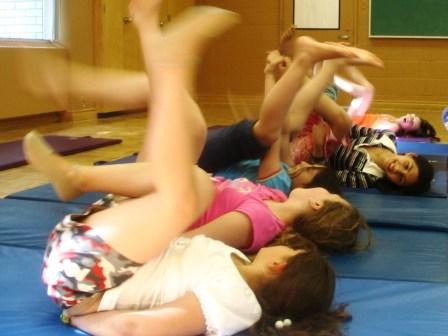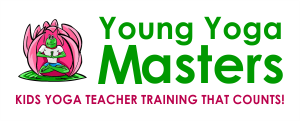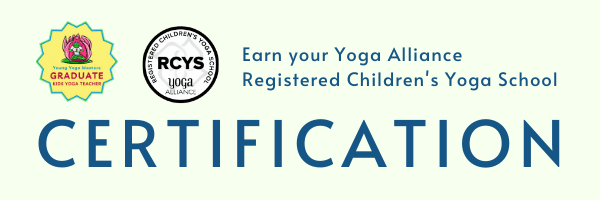This guest post is by Bekah Starr of Sproutin’ Yoga. She explains why she registered for our training this weekend even though she’s been teaching kids for five years. She also gives you two new classroom management tips and shares the challenges she still experiences as a teacher (and she’s not alone!).

Be Clear on What You Want in Kids Yoga Training
by Bekah Starr, Kids Yoga Teacher
Even though I’m trained as a Hatha/ Vinyasa yoga teacher for adults, I’ve been teaching kids yoga for about 5 years now instead. Why? I find it to be lighter, less serious, more fun!
The joy and excitement that kids bring to everything lights me up everyday and I feel truly blessed to offer the teachings of yoga to kids in “kid sized” portions.
I also have to admit; I understand yoga and the philosophies of yoga much more since I’ve been teaching kids. Somehow breaking down the concepts for kids makes it easier for me to understand too. Maybe it doesn’t have to be so complicated after all…
Challenge: Kids Off their Mats and Running Around
Don’t get me wrong; teaching kids also has its challenges. Children can be much less forgiving than adults. If I don’t plan well and keep them interested they get bored VERY easily. And once they’re gone, they’re gone. They’re off running around the studio, playing tag and such, even though there is a rule to “stay on your mat.”
While it is nice to keep it simple, less complicated, and less serious then you might with adults, the rules can get lost with all the innovation and creativity.
So this weekend I’m excited to be traveling from Buffalo, USA to Toronto, Canada for the Young Yoga Masters Kids Yoga Teacher Training.
I want Training for New Games and Classroom Management Tips
I’m making the weekend investment because I gotta find lots of creative ways to impart new ideas and concepts. My hope is that at the Young Yoga Masters weekend I’ll learn some new ways to share yoga with kids, new games and fun ways to teach. And to discover how to keep the children on their mats! Is that possible? J
One thing I use now that works well is breath. Doesn’t that work for you too? Take a deep breath. It’s universal, it really is. I use breathing a lot in my classes and it seem to work well, especially when I have the kids make wind with their breath. Sometimes I use books to illustrate a theme in class and I have them stay focused by making wind with their breath and blowing the next page open.
A Handy Tool I Use Now for Classroom Management
Let’s take for example my 3-4 year old classes, I teach 3 of these a week. This past week particularly has been a hard week to follow the “stay on your mat” rule. It’s warm and sunny out, I get it, they want to run outside, like little wild animals. Which can be really cute, if they would just stay on their mats for a few minutes so I can teach a few poses.
I have one little boy in particular who likes to lead the others around. He happens to be the oldest, so the others follow quite readily. He also happens to be the most rambunctious.
Responsible Kids Make a Calm Kids Yoga Class
In the beginning, these two qualities added up to a lot of frustration for me. Now, I’ve given him an important job. I’ve made him responsible for leading us in a deep breath between each pose.
We learn a new pose, move around in it and feel how our bodies can make lots of shapes. Then when it’s time to focus again I ask this little boy to lead us in a deep breath.
It’s hard to move around and lead a deep focused breath at the same time for a 4 1/2 year old. He’s got to stand still to do it, so the other children follow him and stand still as well. It’s centering and calming for everyone and I can teach whatever I need to.
I invite you to try this too. When your feeling a bit out of sorts refocus yourself with a deep breath. Teach it to others too, it’ll change your world!
Watch for my follow-up blog, coming after the training where I share my experience of the course and how the tools worked with my rambunctious kids.


I don’t think it crosses a line as long as everyone is still having fun. With preschoolers you do have to watch closely for when the fun turns to anxiety because it can happen so fast. As much as we are there to teach peace and love and harmony, kids are naturally drawn to the drama created in cat and mouse games. Or, warrior and dragons. Banning all ‘violence’ isn’t realistic. Giving it a chance to play out safely in class is a healthy thing. This is my 2 cents anyway. 🙂
Thanks for your 2 cents.
I agree, sometimes kids get really shocked when they see a cat eat a mouse or when they figure out that the food on their plate is actually from a pig or a cow.
I think I’ll write a blog post about this one day. I have a few great folk tales where people or animals die in them that I usually change for the little ones. But with the older kids I go back and forth on whether they should die or get removed some other way.
Thanks for the guest post Bekah. I’m looking forward to meeting you in person.
BTW – I also find the kids very rambunctious at this time of year. It’s especially hard if you’ve got a large class. Some of my classes of 3-4 y/o have 20+ kids in them and the teachers who usually help are busy doing stuff on the sidelines. A physical activity like yoga can turn into a big pile on in no time.
I have some games that help that we’ll cover this weekend. But the kids like one we play where they’re mice (child pose) and I’m a big alley cat so they have to be quiet. Now the kids say “be the cat, be the cat” and I walk around the room looking for lunch. It’s kinda gross but the kids, especially that age, love it.
They are mice, you are the cat.
What does the cat do?
Can you follow through on the whole game?
Thanks!
Susan, CRYT
Hi Susan,
Think of it more like an activity to quiet the class than a game. I’m the cat, they’re the mice (in child pose). I walk around the room while they try to be quiet, even though they may be giggling or sometimes squealing with excitement when I come near. But the point is, it get’s them to come to their spot and pay attention.
That’s it.
Once they’re all in child pose and I’ve walked around, then I tell them the next pose.
It’s a simple activity that I don’t use between every pose or in every class – or it would get old. I use it at times when the kids need help settling down. Maybe once or twice a class, with young kids when you play it once, they like to repeat it.
Sometimes as the cat I say “MMMM I’m hungry for some lunch!”
What do you think – too far? have I crossed the line?